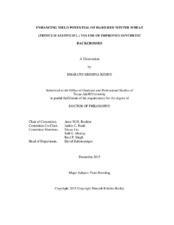| dc.description.abstract | Wheat (Triticum aestivum L.) is the most-widely cultivated and third most-produced grain crop in the world. Wheat contributes 19% calories and 21% protein of the global population diet. With an astounding increase in this global population, that is projected to reach 9 billion by 2050, demand for wheat is expected to reach 900 million tons by 2050. However, narrow genetic base and continued pressure from abiotic and biotic stresses pose a tough challenge to achieve the expected increase in grain yield.
Research leading to the evolution of synthetic hexaploid wheat (Triticum durum x Aegilops tauschii) and synthetic derived wheat (SDW) (elite bread wheat X synthetic hexaploid wheat) provided a tremendous opportunity to improve wheat production. Preliminary studies showed that SDW had the potential to increase grain yield due to larger seed size and weight. However, heads per square meter and seeds per head are also major determinants of grain yield. Single seed weight was found to be highly heritable in SDW populations in our previous studies. Therefore, we hypothesized that indirectly selecting for heads per square meter and seeds per head, while maintaining single seed weight, will boost yield further.
Multi location yield trials were conducted in 2013 and 2014 to determine grain yield and it’s components, morphological traits, resistance to green bug (Schizaphis graminum, Rond), leaf rust (Puccinia triticina), stripe rust (Puccinia striiformis f.sp. Tritici), and powdery mildew (Erysiphe graminis f. sp. Tritici). We estimated quantitative genetic parameters including variance components, heritability, and genetic gain. In addition, we determined response to direct selection and correlated response to an indirect selection using heads per square meter and seeds per head as the indirect selection components. We further estimated the efficiency of indirect selection.
Multi-location yield trials indicated certain SDW produced higher grain yield than their recurrent parents and common check varieties. Comparison of the top ten yielding SDW lines mean with the mean of recurrent parents showed SDW lines produced 11.7% higher grain yield than recurrent parents. The SDW lines maintained a similar number of seeds per head and heads per square meter as recurrent parents but had 10% higher single seed weight. Also, SDW showed higher levels of leaf and stripe rust, greenbug, and powdery mildew resistance compared to their recurrent parents. There were certain indications to show that some resistance was transmitted from primary synthetics. Genetic analyses, such as the genotypic coefficient of variation, heritability, and genetic gain showed that there is tremendous scope for grain yield improvement by utilizing SDW. Genetic gain results indicated that grain yield can be improved by 15.6% per cycle at 10% selection intensity (i = 1.76). The efficiency of indirect selection for yield, using heads per meter square, was only 0.41. Similarly, seeds per head and single seed weight had an efficiency of 0.46 and 0.21, respectively.
These results indicate that SDW contributed some favorable alleles for yield, biotic stress resistance, and abiotic stress tolerance. These results also showed that SDW contributions were advantageous under both rainfed and irrigated conditions, which makes them an invaluable source for increasing genetic diversity and improving performance of Texas A&M AgriLife wheat germplasm. | en |


